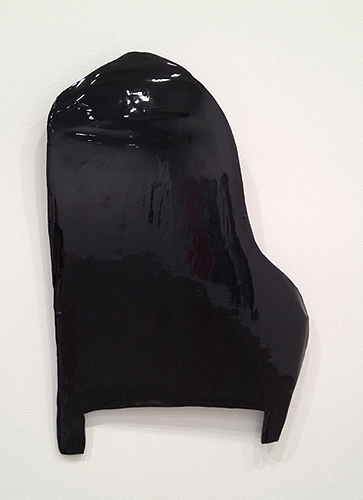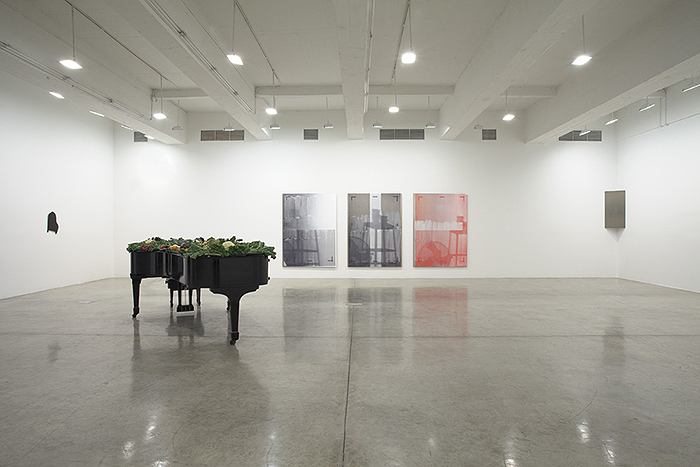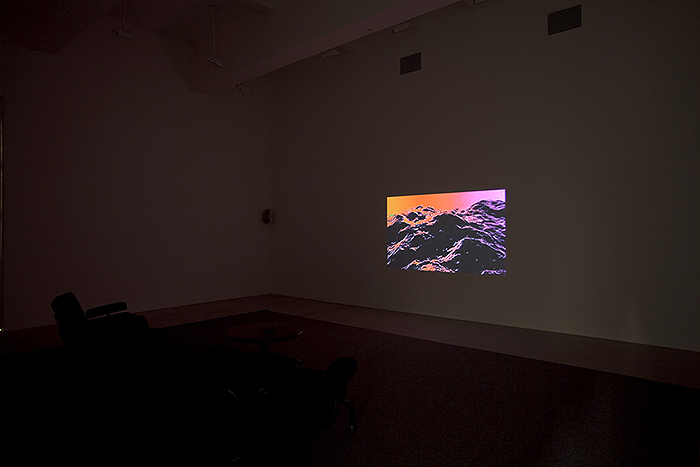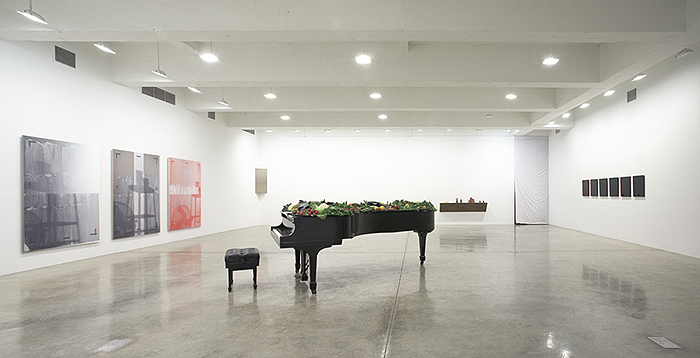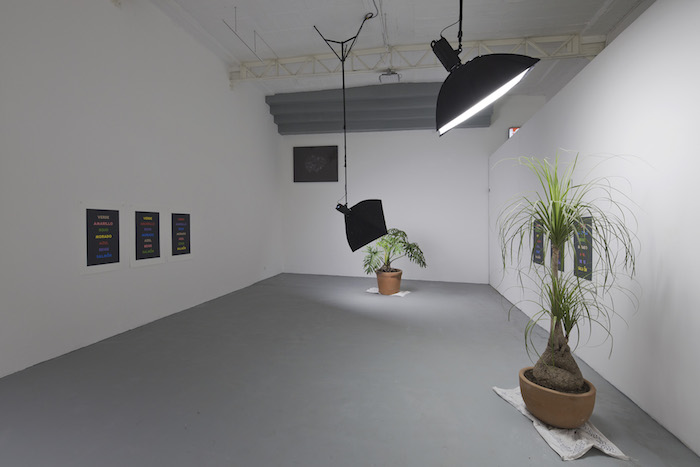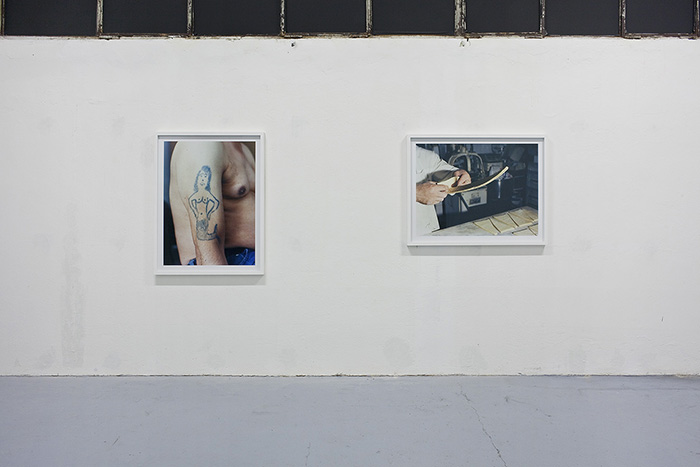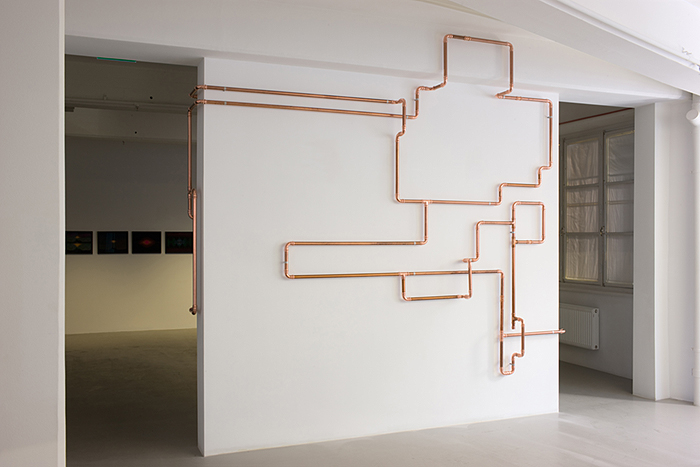June 20–July 26, 2013
The title of the group show currently on view at Tanya Bonakdar, “ambient,” invites historical speculation. Where does ambience settle as an interpretive framework? The show even designates an event, of sorts, that puts forward ambience as an artistic strategy. The press release opens with an anecdote from the liner notes of Brian Eno’s 1975 Discreet Music. Apparently, Eno had located the origins of ambient music in something that happened to him while bedridden after an accident: “After a friend placed a recording of eighteenth-century harp music on the composer's turntable before departing the room, he realized the stereo amplifier was at such a low level that the music (which was also playing only through a single channel) was nearly inaudible, blending with the ‘color of the light’ and ‘sound of the rain,’ and residing at or just beneath the threshold of perception.” We can read the works in “ambient” as evidence submitted to determine the subsequent significance of this innovation.
The production, in 1975, of things existing “at or just beneath the threshold of perception” superficially recalls two things: phenomenology—or the philosophical investigation and analysis of perception in the work of thinkers like Edmund Husserl and Maurice Merleau-Ponty—and Minimalism, whose contested history is detailed by Hal Foster in “The Crux of Minimalism.” Foster pairs Minimalism with Pop art as complementary responses to the same set of social phenomenon, which he understands through the lens of late capitalism (borrowed from Georg Lukács by way of Ernest Mandel). He adds this Marxist interpretation to that of Rosalind Krauss, who, he argues, rolls up her reading of Minimalism with phenomenology and structural linguistics equally, and thus covers over the critique of the subject that is present in the latter but missing in the former. Minimalism’s occasional concern with language, which destabilizes the subject (or ought to), is in tension with its focus on perception, which rests, implicitly, on the very idea of a stable and perceiving subject.
We now have three intellectual paradigms on the table: phenomenology, structural linguistics, and Marxism, and two artistic ones, Pop and Minimalism. Let ambient be a third, if only for the duration of this text. This opens the question of the relationship between each of these terms, which the addition of ambient might clarify. Certainly Eno is not a pop musician in the way that Warhol was a Pop artist, at the level of content, but nor, frankly, is he a pop musician at the level of form. Ambient music is still too minimalist for that, refusing the clarion legibility and rhythmic consistency—in short, the seriality—that distinguishes popular musical production from the classical or modernist kind.
And yet “ambient,” curated by Tim Griffin, is not fully minimalist, either. (It includes works by a range of artists: Dike Blair, Liz Deschenes , Olafur Eliasson, Susan Goldman, Mary Heilmann, Nathan Hylden, Sherrie Levine, Tristan Perich, Seth Price, Nick Relph, Haim Steinbach, and Alex Waterman/Walter Marchetti.) For example, Marchetti’s Natura Morta (1988) is a Steinway piano adorned with a selection of moldering produce and (when I saw it) surrounded by five empty chairs. I was reminded of John Cage. A comparison of Cage and Eno is helpful when considering the distance between Minimalism and ambient. There is a clear difference between Cage’s silent piano, which stays fully rooted at the center of our perception, and Eno’s work, which, like the pungent decay of the produce, steps constantly on and off our mental stage.
Heilmann’s Piano (1983), by contrast, is minimal without being ambient, a small, shiny hunk of black sculpture hanging on the wall. Its surface is distinct from the reflective black sheen of Levine’s Black Mirrors (2004). The shiny black of the piano is intended to reflect the theatrical lighting of the concert hall, to fortify visually that instrument’s aural demand on our attention. Its citation in the Heilmann piece underlines the critique of this authority implicit in the small, misshapen size of her object. Levine’s surface, by contrast, aims to reflect, however dimly, our own presence in the space, moving it back and forth across the threshold of our perception. (If we credit Levine’s work, as Foster does, as having contributed to a sustained, feminist critique of Minimalism, then the inclusion of her arguably most minimalist work becomes even more interesting.)
Two photograms by Deschenes, both Untitled (Charlotte Posenenske) (2012), hang in the corners on both floors of the show, one bent ninety degrees, hugging the wall and one hanging flat, breaking the seam of the walls. Posenenske, whose own minimalist significance was appreciated only later, stopped making art in 1968. Pessimistic about art’s ability to influence or represent social problems, she instead became a sociologist specializing in issues of employment and labor. This substitution—of industrial sociology for art—could be read as a confirmation of Minimalism’s distance from Marxist criticality, or, perversely, as evidence of its close proximity, depending on whether we foreground the underlying continuity of Posenenske’s subjectivity as a producer, or if we instead take the decision to produce one thing (industrial sociology) over another (minimalist art) as indicating a real rupture.
In Price’s Koln Waves/Blues (2005/2008), a stunning 16mm to video transfer installed in the very back of the gallery, a generic computer-generated vision of floating on the high seas is quickly undone as colors emerge and the light shifts, making the waves into translucent structures. The figure of the wave slips into geometric abstraction as musical elements, similarly torqued, surface and evaporate while a collection of neon symbols make occasional appearances at the center of the screen. The symbols form a visual palindrome—it looks something like “bood"—a recognizable pattern that is nevertheless nonsense; linguistic without being legible. The language function is not directly addressed, as it is in, say, the work of Gary Hill, but floats to the surface from time to time.
Many of the works in “ambient” are not ambient. Each moves, rather, in its own way, back and forth across different registers of consciousness. Sometimes this is sensual perception—visual, auditory, or olfactory—sometimes it is conceptual cognition. This movement redraws an old constellation—a way of eliding the strictly demarcated play of presence and absence in Minimalism, while not yet approaching the aggressive transparency of Pop. Realizing neither imperative, it is not resolved into pastiche or parody. Theatrical without being performative, present but not specific, “ambient” presents a haunting strategy of ambivalence that repays sustained consideration by resisting it.

